The Academy of Model Aeronautics offers many grant opportunities for clubs. Read below to find out more about all available opportunities.
All grant applications have moved to our new grant platform. All grant questions should be directed to AMA Foundation Deputy Director Rachelle Haughn at (765) 287-1256, ext. 221.
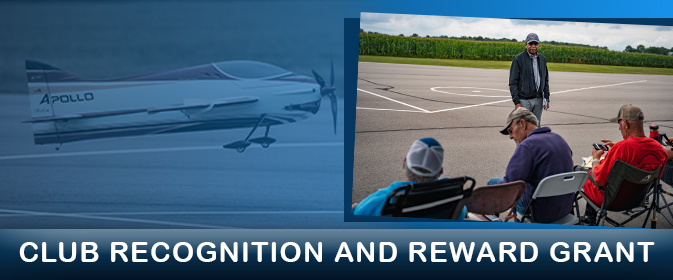
Application Available: Year-Round
Award Announced: Within 2 weeks of application submission
Minimum Award Amount: $50
Maximum Award Amount: $175
The Academy of Model Aeronautics encourages clubs across the country to take part in events and serve the community in ways that will entice community members to learn more about the hobby of model aviation. Becoming a vital part of your community will help your club build your membership and inspire others, including the youth in your community. To encourage clubs to promote model aviation, the AMA offers clubs cash incentives for positive local media coverage for a public event, public service, club announcement, or other coverage.
If your club has received publicity through the local media, you can submit the article, radio segment, or television clip and receive up to $175 for shining a light on model aviation.
*National Model Aviation Day events do not qualify for Club Recognition and Reward Grants.*
Qualification Rules
- The club must be a current AMA chartered club.
- The coverage must include the club's name and information about model aviation.
- Applications must be submitted within 3 months of the media coverage.
- This program promotes earned media, not paid media. Ads purchased (or free) will not qualify.
- Event coverage will only be recognized if the event is open to the public.
- Clubs can apply several times throughout the year. Awards are based on a first-come, first-serve basis. When the allotted budget for the year is reached, awards will be discontinued for the year.
- Clubs can be awarded a maximum of $175 per year.
- Awards are based on the type of media coverage, not the frequency of coverage. For instance, two $50 awards will not be given for coverage in two different newspapers.
How Cash Awards Are Determined
Newspaper and magazine coverage will receive $50, radio coverage will receive $100, and television coverage will receive $150. If coverage is published in more than one media outlet, the recipient will receive the highest payout award. For example, if a club is featured in the local newspaper, in a radio interview, and on television, it would receive $150 as long as the other qualification rules are followed.
NOTE: If a club has already received an award for the year, it may not receive the full award amount. Clubs can only receive $175 total per year, no exceptions.
Receive An Extra $25
Clubs can receive up to $25 for one of the following:
- The coverage includes the words "Academy of Model Aeronautics" spelled out or verbally said in the piece.
- The event receiving recognition is a club fundraiser held to benefit a community organization.
NOTE: Only $25 can be earned in bonus cash. Bonus cash will only be given if the club has not exceeded the $175 maximum per club, per year.
Submitting Your Application
To apply, please complete the online application. Mailed applications will not be accepted. Applications will be reviewed by the AMA Foundation deputy director, who will award the appropriate funds.
Apply for a Club Recognition and Reward Grant HERE.
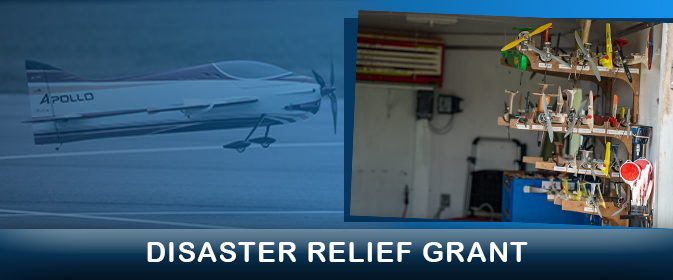
Application Available: Year-Round
Award Announced: Within 2 weeks of application submission
Maximum Award Amount: $1,000.00
Established in October 2005 by the AMA Executive Council, this program is designed to grant immediate financial assistance to AMA chartered clubs that have flying sites damaged by a natural disaster such as a hurricane, earthquake, flooding, firestorm, etc. The grant is designed to assist clubs in clearing debris and/or making repairs so that the field is once again accessible and usable by club members. It is not designed to pay for repairs to structures or facilities that were damaged by vandalism, theft, or wild animals.
Submitting Your Application
To apply, please complete the online application with the required information and photos of the damage your site incurred. The application allows for these items to be attached electronically, but all items must be received before an award will be granted. The club is responsible for submitting this information.
The Deputy Director will review the application and award the appropriate funds.
Apply for a Disaster Relief Grant HERE.
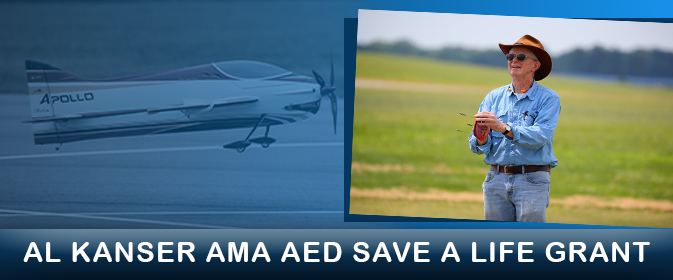
Application Available: Year-round
Award Announced: Within two weeks of application submission
Maximum Award Amount: $200
In 2023, the Academy of Model Aeronautics Foundation created the Al Kanser AMA AED Save A Life Grant to help promote safer and more medically equipped flying sites. This grant is designed to reimburse clubs for 25% (up to $200) of the cost of a recently purchased Automated External Defibrillator (AED). AEDs, which are easy to use, can be critical when helping someone who is experiencing sudden cardiac arrest.
Eligibility
All AMA chartered clubs and chapters are eligible to apply under the following guidelines:
- Must have already purchased the Automated External Defibrillator (AED) within the last 2 months at the time of application submission.
- Must have and provide a photo of the receipt of purchase.
How the Al Kanser AMA AED Save A Life Grant Works
Awards for the Al Kanser AMA AED Save A Life Grant are based on a first-come, first-served basis. When the allotted budget for the year is reached, awards will be discontinued for the year. Clubs can be awarded a maximum of $200 per year.
The AMA has also entered into an official partnership with the Red Cross, which will provide AMA members and AMA chartered clubs with specialized offers for First Aid, CPR, and AED training, as well as discounts for AED devices. Contact Miranda Groh at (615) 339-0753 or miranda.groh@redcross.org to get more details on discounts and training.
Note: Neither the Academy of Model Aeronautics nor the Academy of Model Aeronautics Foundation retain liability for the club's purchase of an Automated External Defibrillator. It is the responsibility of the club and its members to receive proper AED training and maintain the device.
Submitting Your Application
To apply for an Al Kanser AMA AED Save A Life Grant, please complete the online application with the required information and photo of the receipt of purchase. The application allows for information to be added and attached electronically, but all items must be received before an award will be granted. The club is responsible for submitting this information.
The Deputy Director will review the application and will award the appropriate funds within two weeks of the application submission. Apply for the Al Kanser AMA AED Save A Life Grant HERE.
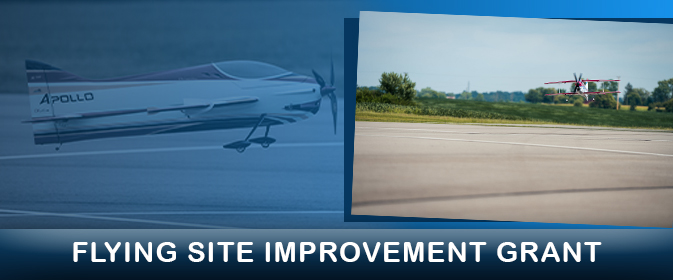
Application Available: October 1, 2025
Optional Application Draft Deadline: January 6, 2026
Final Application Deadline: February 1, 2026
Award Announced: May 2026
Minimum Award Amount: $100
Maximum Award Amount: $3,000
The Academy of Model Aeronautics (AMA) and AMA Foundation are committed to supporting its members through philanthropy. The Flying Site Improvement Grant program provides funding for AMA chartered clubs that have made improvement or are making improvement to their flying sites. We understand that well-maintained flying sites promote satisfaction among hobbyists, club visibility to the public, community engagement, aviation education, and safety.
Through the FSIG program, the AMA will contribute 25% of total project costs - with a minimum contribution of $100 and a maximum contribution of $3,000 - to clubs that are improving their flying sites and demonstrating their club's commitment to AMA's mission statement: To promote, advance, and safeguard model aviation as a hobby, sport, and educational tool.
Eligibility
All currently chartered AMA clubs are eligible to apply. Grant applications can be submitted by any club member appointed by the club president. Clubs are eligible to apply for funding for a project completed within the last 12 months of the application deadline or projects that will be completed within 12 months of the application deadline.
Clubs who have applied for and were awarded FSIG funding in previous years are eligible to apply each year, but priority will be given to clubs that have never received FSIG grant funding. Additionally, clubs who have been awarded FSIG funding in previous years must have submitted their final reports prior to or by the final application deadline to be eligible for grant funding in the current cycle. No exceptions.
Examples of What We Fund
- installation or repair of GeoTextile runway(s)
- installation or repair of asphalt/concrete/gravel runway
- purchase of grass seed for runway installation or repair
- purchase of gravel, cement, or asphalt for driveway installation or repair
- equipment rental for runway, driveway, or fence installation or repair (including fuel expenses, typically added into equipment rental costs)
- installation of drain tiles
- trenching equipment and drain tile or hose to move water around the runway and parking area
- purchase of building materials
- purchase of a used shipping container, including site delivery and purchase of materials to paint, vent, and seal the roof
- purchase of mower
- purchase of land
- purchase of materials for safety fence or boundaries
- hire of a professional to roll the field with multi-ton roller
- purchase of a flagpole for a wind sock
Examples of What We Don't Fund
- purchase of an automated external defibrillator
- fuel for mowing the field
- oil changes or battery replacement for rental equipment
- relocation of a portable toilet (Porta Jon, Porta Potty, etc.)
- operational or overhead expenses (e.g., lawn mowing services, additional required insurance beyond AMA insurance that the landowner or local government requires)
- repair of mower
- property rental
- membership fee subsidization
- food or beverages provided to workers improving the flying site
- administrative costs (compensating or reimbursing club officers or members for labor or expenses)
- bank loans
Grant Application Requirements
Successful applications will indicate a clear need for site improvements, describe a reasonable plan and timeline to address the need, and provide an accurate budget that shows all expenses. Furthermore, we are interested in applications that tell a club’s story, such as a brief history of the club, the club’s flying site condition, typical flying activities and events, community and/or charitable involvement, membership recruitment, and long-term goals and plans for the club. We want to get to know your club and its needs through your application. Successful applications will effectively tell a club's story and present a compelling flying site improvement need.
To be considered complete, an application must include all requirements below. Each item should be typed into the appropriate box on the online application.
Project Description—a rationale for the completed or proposed project. Address the following in 250 words or less:
- describe the current condition of the flying site (or its past condition) and what factors have contributed to its condition
- indicate the need, problem, or challenge your improvement project addresses or addressed
- describe the project’s impact on the club and its community (i.e., what club or community events [fun-flys, fundraisers, young pilots' program, etc.] will be made possible by this improvement)
- demonstrate how the improvement project aligns with and supports AMA's mission
- describe the club’s efforts to fundraise and/or save money for the project
Project Work Plan & Timeline—A description of the work completed or work to be completed, who completed it or will complete it, and the time required for the project. Address the following in 250 words or less:
- explain specific activities, labor, and/or tasks that were completed or will need to be completed from the project start date to the project completion date
- indicate who will implement and manage the improvement project
- indicate who was or will be involved in the project and the extent of their involvement (indicate whether club members and/or the community will be involved)
-
explain when and in what sequence the improvement occurred or will occur
Project Budget—An itemized list of expenses for the project. Please create a budget worksheet using whichever software you are most comfortable with (Excel, Word, Adobe, etc.). Each line item should be referenced in the project justification and the project work plan. The budget form requires each applicant to indicate the amount requested from the AMA. This amount should be 25% of the total project costs, not to exceed $3,000. Project costs can only include amounts spent since the previous year’s application cutoff date (February 1, 2025), or projected work.
Note: All receipts must not contain personal items, but only those items that are being submitted with the club's Flying Site Improvement Grant application.
Appendices—supplemental evidence of improvements needed. Please include the following:
Required
- photos of flying site conditions (before photos of what will be improved/what has been improved)
Optional
- letter of support from external consultant or professional attesting to the conditions of the flying site and/or the need of the project
- any additional materials the club would like to submit
Note: Only receipts or quotes that have been paid or will be paid for by the club are eligible for the grant program, and all receipts and/or estimates must equal the amount requested by the applicant. Other funding that the club might receive, such as additional grants and/or individual monetary contributions, do not qualify for reimbursement for the FSIG program. Any grant funds unused by the club must be returned to the AMA. If a club received a Disaster Relief Grant related to the project, that must be noted on the application. Receipts must not contain personal items, only those items that are being submitted with the club's Flying Site Improvement Grant application.
Submitting Your Application
Final applications must be submitted through the online application form by February 1, 2026. No late or incomplete applications will be accepted.
AMA encourages applicants to submit an optional draft of their application no later than January 6, 2026, for preliminary feedback and review. This opportunity gives applicants a chance to submit a complete rough draft of their application, so they can receive preliminary feedback. In this stage of the process, applications will be reviewed by the Deputy Director and the club’s District Vice President.
Applicants can notify—and are encouraged to notify via email—the Deputy Director earlier than January 6 that they would like feedback. To receive feedback on your application draft, you must begin and complete the first page of your application. The applicant must email the Deputy Director at foundation@modelaircraft.org to receive feedback. If an email is not sent, the application will not be reviewed. Feedback will be returned to applicants within two weeks of notifying the Deputy Director.
Note: Optional draft feedback does not guarantee your club's grant request will be filled by the judging committee.
Note: Applicants who opt for feedback must revise and submit their final application by February 1 to be considered for funding. Applicants who submit an optional draft but who fail to submit a final draft will not be considered for funding. Applications that do not have a completed W-9 on file with AMA HQ by February 1, 2026, will be ineligible for the grant.
Grant Review Process
The grant review begins in February and ends in mid-April. After all applications are received, they are reviewed by the Deputy Director to ensure they are complete. Applications are made anonymous and sent to FSIG review committee. Members of the grant review are appointed from each district by the District Vice President, with each district represented. Review committee members evaluate and score each application on the following criteria:
-
project need
-
project workplan & timeline
-
impact on club & community
-
alignment with AMA's mission
-
project budget
The committee members score each criterion between 0 and 4. View the rubric here. The minimum number of total points that an application can receive is 0 and the maximum number of points is 20 (or 23 with bonus points). Bonus points are intended to (a) prioritize clubs that have never received funding or have not received funding in the last 3 years and (b) incentivize Leader Clubs. Bonus points can be added to application scores based on the following items:
+5 points: clubs who have never received FSIG funding
+1 point: clubs who have not received FSIG funding within the last three years
+1 point: clubs who hold Bronze or Silver Leader Club status
+2 points: clubs who hold Gold Leader Club status
For example, if a club who has never received FSIG funding obtains a final score of 19 points, 5 additional points would be added to its score, making the new score 24 points.
Applications receiving 5 points or fewer will not be considered for funding. Applications receiving 6 points or more will be considered for funding. Reviewers’ scores for each application will be averaged and then the average score for each application will be ranked from highest to lowest. In the case of major discrepancies among reviewers’ scores for an application, the AMA will have the panel of reviewers meet to discuss the score differences. The application will then be rescored, and the average of the rescores will be the official final score. Funding will be granted first to the higher-scoring applications until all grant funds have been distributed. After the review committee has scored applications, the list of potential recipients will be sent to the AMA Executive Council (EC) for approval and will be announced after the second quarterly (spring) meeting, typically held in April each year.
Award Information
After the EC votes, all applicants will be notified of award results by email, regardless of whether they were awarded funds. Furthermore, the AMA will officially announce the grant recipients through its various communication and media channels. Checks will be generated after the recipients are selected and will be mailed shortly thereafter. Checks typically arrive in late May.
Reporting
Clubs that received FSIG grant funds for a future project must complete their improvement project and submit a final report no later than 12 months after receiving FSIG funds. The final report assures the AMA that the project was completed and that all grant funds were used for the purposes described in the original application. Furthermore, the final report is stored for auditing purposes, thus the AMA must receive a report from every grant recipient. During the 12-month grant period, AMA reserves the right to request updates from clubs via email or phone about the club’s progress, the status of the project, and the projected completion date. If a club does not use the grant funds for the purpose stated in the application, the grant money must be returned to AMA.
Within 30 days of completing the improvement project, the club must submit its final report to the AMA, which should include a short project reflection; a finalized budget of expenses and receipts; and before and after photos of the project. All grant awardees will receive additional information at the time of their award notification about writing the final report. Please note: clubs that complete their improvement project well within the 12-month timeline must still submit their reports within 30 days of completing the project. For example, if a club receives grant money May 15, 2026, it has until April 15, 2027, to complete its project. The final report would be due 30 days following, or no later than May 15, 2027. If a club completes its project, for example, September 2, 2026, the club would have until October 2, 2026, to submit its final report.
Clubs that receive retroactive FSIG grant funds for projects already completed do not need to submit a progress or completion report. The grant application submitted by the club serves as its completion report, assuming it submitted all of the grant application materials (receipts, photos, etc.).
If a club determines that its project cannot be completed within a 12-month timeframe, a written explanation must be submitted to the Deputy Director, indicating the project’s status and anticipated completion date. If the completion date exceeds 18 months of the receipt of the grant, the AMA reserves the right to request that the entire amount of the grant be returned. Also, please note: the project and final report must be completed and submitted before the next year’s application deadline in order for the club to be eligible to apply again for FSIG funds.
Frequently Asked Questions
-
Who can apply for a Flying Site Improvement Grant?
All current chartered AMA clubs are eligible to apply. Grant applications can be submitted by any club member who is also an AMA member. Please note that only one application can be submitted per club.
-
What is the difference between the optional draft deadline and the final deadline?
To promote successful applications, the AMA encourages applicants to submit a complete draft of their application for feedback and review by the optional draft deadline, which typically falls three to four weeks before the final deadline. This opportunity allows applicants a chance to submit a complete rough draft of their application so they can receive preliminary feedback on their grant application from the Deputy Director and their District Vice President. The optional draft does not count as the final application. All applicants who submit an optional draft must also resubmit their final draft by the final deadline, which is February 1. Although the optional draft deadline is voluntary, the final deadline must be met for consideration.
-
What do I need to prepare if I want to submit an optional draft?
Clubs that submit an optional draft must submit a complete online application that includes a completed budget form and attached photos and receipt/estimates.
-
How much funding can my club receive?
The AMA will contribute 25% of a club’s total project costs—with a minimum contribution of $100 and a maximum contribution of $3,000.
-
My club has received a Flying Site Improvement Grant before. How soon are we eligible to apply again?
All clubs are eligible to apply for a Flying Site Improvement Grant every year, including clubs that received grant money within the last three years.
-
Our flying site was affected by a natural disaster. Can we apply for FSIG grant money?
Yes. Clubs may apply for FSIG grant money to repair natural disaster damage to flying sites. Clubs whose flying sites have been affected by natural disasters may also apply for grant funds from the Club Disaster Relief Fund, which distributes up to $1,000 per incident for repairs. Clubs must indicate in their FSIG applications whether they received Club Disaster Relief Funds for the proposed improvement project.
-
When will my club be notified if we’ve received the FSIG grant?
Shortly after the Executive Council’s spring meeting, all applicants will be notified of award results by email—regardless of whether they were awarded funds or not.
-
Who should I contact with questions about the FSIG or other AMA grants?
Please direct all questions to Rachelle Haughn, Deputy Director, 5161 E. Memorial Drive, Muncie, IN 47302- Email: foundation@modelaircraft.org
-
Phone: (765) 287-1256, ext. 221
-
What kinds of improvements does the FSIG fund?
The FSIG funds improvements such as installation or repair of a runway (GeoTextile, asphalt, cement, gravel, grass seed), installation of drain tiles, purchase of a mower, and the purchase of materials related to safety (safety fence). Please see the FSIG guidelines for examples of other allowable improvements.
-
What kinds of improvements does the AMA not fund?
The FSIG does not fund improvements such as fuel for mowing the field, food or beverages provided to workers who are improving the site, property rental, administrative/overhead expenses or automated external defibrillators. Please see the FSIG guidelines for examples of other disallowed improvements.
-
My club received grant funding and we started our project but won’t be able to complete it within 12 months. What should we do?
If a club determines that its project cannot be completed within a 12-month timeframe, a written explanation must be submitted to the Deputy Director, indicating the project’s status and anticipated completion date.
-
What do I include in my final completion report?
Within 30 days of completing the improvement project, a club must submit its final report to the AMA, which should include a short project description/reflection; a finalized budget of expenses and receipts; and post-improvement (“after”) photos of the project.
-
My club sought funding for a project we already completed. Does my club need to submit a completion report?
Clubs that receive retroactive FSIG grant funds for projects already completed do not need to submit a progress or completion report. The grant application submitted by the club serves as the club's completion report, assuming all of the grant application materials were submitted (receipts, photos, etc.).
Apply for a Flying Site Improvement Grant HERE.
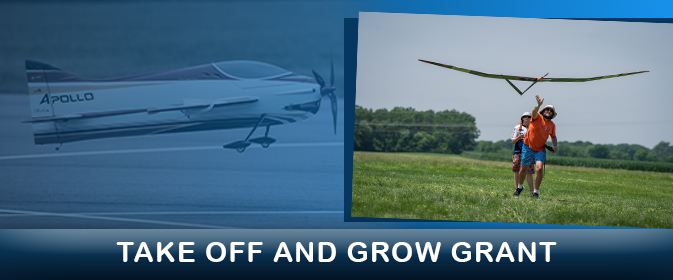
Application Available: October 1, 2025
Final Application Deadline: February 1, 2026
Award Announced: May 2026
Maximum Award Amount: $1,000
Do you want to introduce model aviation to your friends and neighbors and receive local recognition and financial benefits in return? If you answered "yes," then you'll want to know more about AMA's Take off And Grow Grant.
Developed to encourage our members and clubs to promote modeling as a positive recreational activity to those in their communities, TAG was the first of several programs implemented by AMA in 2007. Intended primarily to welcome the general public to aero modeling, TAG provides a one-day extensive introduction of model aviation with the intent of drawing new people into the model aviation hobby.
Eligibility
AMA chartered clubs and chapters are eligible to apply under the following guidelines. Awards are made to an AMA club or chapter, which will also assume responsibility for the filling of all program reports with the AMA Foundation, as outlined below. Each organization awarded a grant must agree to the following:
- To provide a detailed write up of the success of the event, both including a photographic record of the highlights of the project.
- To provide a general accounting of the expenditure of project funds and a statement concerning the planned expenditure of any unexpended project funds.
- To retain any equipment purchased with AMA funds as property of the sponsoring organization or a local AMA club.
- To allow the AMA to distribute and/or promote the project information through its membership services.
How TAG Works
If your club is selected to receive a TAG Grant, AMA will provide up to $1,000 to use to set up your program. At the end of the event, items purchased are your club's to keep as AMA's way of saying "thanks for helping out."
Remember, too, that the rewards are more than just the things listed above. Hosting a TAG event is a great way to reach out to your community to give it a taste of a family-oriented recreational activity that all of us enjoy so much. In addition, you'll be creating positive relationships with your neighbors that quite often can help when the time comes to keep or acquire new flying sites.
As with all of our developing programs, the AMA wants to provide the tools local clubs need to ensure the popularity of their hobby. It will require the cooperation of many to make it a success. Achieving that success will make our already wonderful hobby even better.
Submitting Your Application
Final applications must be submitted through the online application form by 11:59 p.m. on February 1, 2026. Applications missing a completed W-9 will be ineligible. No late or incomplete applications will be accepted.
Applications must be submitted by one club member who has been appointed by the club president. Each section of the grant application must be complete for the application to be eligible for committee review.
Grant Review Process
After applications are received in February, they will be reviewed by the Deputy Director to ensure applicants are eligible to apply and that the application is complete. The applications are then sent to the corresponding District VP, who will score the application. Applications are evaluated on a points system with the first-time applicants moving to the top. All District VPs will score applications using the same rubric. As the demand for these grant funds fluctuates, not all applications are guaranteed to be fully funded
Apply for the Take off And Grow Grant HERE.



